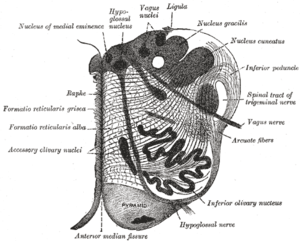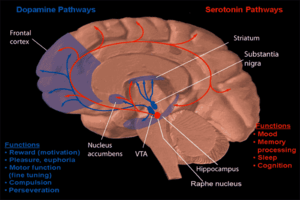Raphe nuclei
The raphe nuclei (Greek: ῥαφή, "seam")[1] are a moderate-size cluster of nuclei found in the brain stem. They have 5-HT1 receptors which are coupled with Gi/Go-protein-inhibiting adenyl cyclase. They function as autoreceptors in the brain and decrease the release of serotonin. The anxiolytic drug Buspirone acts as partial agonist against these receptors.[2] Selective serotonin reuptake inhibitor (SSRI) antidepressants are believed to act in these nuclei, as well as at their targets.[3]
| Raphe nuclei | |
|---|---|
 Section of the medulla oblongata at about the middle of the olive. (Raphe nuclei not labeled, but 'raphe' labeled at left.) | |
 Horizontal cross section of the brainstem at the lower pons. The raphe nucleus is labeled #18 in the middle. | |
| Details | |
| Identifiers | |
| Latin | nuclei raphe |
| MeSH | D011903 |
| NeuroLex ID | nlx_anat_20090205 |
| TA | A14.1.04.257 A14.1.04.318 A14.1.05.402 A14.1.05.601 A14.1.06.401 |
| FMA | 84017 |
| Anatomical terms of neuroanatomy | |
Anatomy
The raphe nuclei are traditionally considered to be the medial portion of the reticular formation, and appear as a ridge of cells in the center and most medial portion of the brain stem.
In order from caudal to rostral, the raphe nuclei are known as the nucleus raphe obscurus, the nucleus raphe pallidus, the nucleus raphe magnus, the nucleus raphe pontis, the median raphe nucleus, dorsal raphe nucleus, caudal linear nucleus.[4] In the first systematic examination of the raphe nuclei, Taber et al.. (1960)[5] originally proposed the existence of two linear nuclei (nucleus linearis intermedius and nucleus linearis rostralis). This study was published before techniques enabling the visualization of serotonin or the enzymes participating in its synthesis had been developed, as first demonstrated by Dahlström and Fuxe in 1964.[6] Later, it was revealed that of these two nuclei, only the former (nucleus linearis intermedius, now known as the caudal linear nucleus), proved to contain serotonin-producing neurons,[7] though both of them contain dopaminergic neurons.[8]
In some works (e.g.[9]), researchers have grouped the nuclei lineares into one nucleus, the nucleus linearis, shrinking the number of raphe to seven, e.g., NeuroNames makes the following ordering:[10]
- Raphe nuclei of medulla oblongata
- Raphe nuclei of the pontine reticular formation
- Raphe nuclei of the midbrain reticular formation
- Nucleus centralis superior (median raphe nucleus)
- Nucleus raphe dorsalis
Nomenclature
The Latin names commonly used for most of these nuclei are grammatically and orthographically incorrect. Latin grammar would require to use the genitive case raphes ('of the seam') instead of the nominative case raphe ('seam') in these Latin expressions. The main authority in anatomical names, Terminologia Anatomica uses for example nucleus raphes magnus[11] instead of the grammatically incorrect nucleus raphe magnus. The spelling raphe/raphes however can also be contested as numerous sources[12][13][14] indicate that raphe is an incorrect Latin rendering of the Ancient Greek word ῥαφή as the initial letter rho with rough breathing (spiritus asper) is normally rendered as rh in Latin.[12] The edition of the Nomina Anatomica that was ratified in Jena in 1935 used rhaphe instead of raphe.[15][16]
Projections
These nuclei interact with almost every pertinent portion of the brain, but only a few of them have specifically independent interaction. These select nuclei are discussed as follows.
Overall, the caudal raphe nuclei, including the nucleus raphe magnus, nucleus raphe pallidus and nucleus raphe obscurus, all project towards the spinal cord and brain stem. The more-rostral nuclei, including the nucleus raphe pontis, nucleus centralis superior (also called median raphe nucleus) and nucleus raphe dorsalis project towards the brain areas of higher function[17]
However, studies also show that numerous areas of the brain control the serotonergic neurons located in the nucleus raphe dorsalis, including the orbital cortex, cingulate cortex, medial preoptic area, lateral preoptic area, and several areas of the hypothalamus. The connection between these areas, particularly between the nucleus raphe dorsalis and the orbital cortices, is thought to have influences on depression and obsessive compulsive disorder prognosis.[18]

Function
The raphe nuclei have a vast impact upon the central nervous system. Many of the neurons in the nuclei (but not the majority) are serotonergic; i.e., contain serotonin, a type of monoamine neurotransmitter and are modulated through fibrous pathways in the midbrain.[19]
Projections from the raphe nuclei also terminate in the dorsal horn of spinal gray matter where they regulate the release of enkephalins, which inhibit pain sensation.
The raphe nuclei provide feedback to the suprachiasmatic nuclei (SCN), thus contributing in circadian rhythms in animals. The SCN transmits to the raphe nuclei via the dorsomedial hypothalamic nucleus altering serotonin levels for sleep/wake states. The raphe nuclei will then transmit feedback to the SCN about the animal's vigilance and levels of alertness. This reciprocal feedback between the two structures provides an adaptable yet stable basis of circadian rhythms.[20]
The raphe nuclei and the effects of ghrelin
More recent studies of the Raphe Nuclei done with rats involve the effects of ghrelin on the dorsal raphe nucleus. When administered, larger doses of ghrelin act centrally on the raphe nucleus, hippocampus, and amygdala which causes dramatic increases in food intake, memory retention, and increases in anxiety. The effects of ghrelin are seen on the raphe nucleus as soon as an hour after injection, suggesting rapid changes in the structure of the nucleus. Changes also occur after 24 hours suggesting delayed modifications as well.[21]
See also
References
- Liddell, H.G. & Scott, R. (1940). A Greek-English Lexicon. revised and augmented throughout by Sir Henry Stuart Jones. with the assistance of. Roderick McKenzie. Oxford: Clarendon Press.
- George J. Siegel, ed. (1999). "Understanding the neuroanatomical organization of serotonergic cells in brain provides insight into the functions of this neurotransmitter". Basic Neurochemistry. Bernard W. Agranoff, Stephen K. Fisher, R. Wayne Albers, Michael D. Uhler (Sixth ed.). Lippincott Williams and Wilkins. ISBN 978-0-397-51820-3.
In 1964, Dahlstrom and Fuxe (discussed in [2]), using the Falck-Hillarp technique of histofluorescence, observed that the majority of serotonergic soma are found in cell body groups, which previously had been designated as the raphe nuclei.
- Briley, M; Moret, C (October 1993). "Neurobiological mechanisms involved in antidepressant therapies". Clin Neuropharmacol. 16 (5): 387–400. doi:10.1097/00002826-199310000-00002. PMID 8221701.
- Törk, Istvan (1990). "Anatomy of the serotonergic system". Annals of the New York Academy of Sciences. 600 (1): 9–34, discussion 34–5. Bibcode:1990NYASA.600....9T. doi:10.1111/j.1749-6632.1990.tb16870.x. PMID 2252340.
- Taber, Elizabeth; Brodal, Alf; Walberg, Fred (1960). "The raphe nuclei of the brain stem in the cat. I. Normal topography and cytoarchitecture and general discussion". J Comp Neurol. 114 (2): 161–187. doi:10.1002/cne.901140205. PMID 13836517.
- Dahlström, Annica; Fuxe, Kjell (1964). "Evidence for the existence of monoamine-containing neurons in the central nervous system. I. Demonstration of monoamines in the cell bodies of brain stem neurons". Acta Physiol Scand. 232 (Suppl): SUPPL 232:1–55. PMID 14229500.
- Halliday, Glenda M.; Törk, Istvan (1989). "Serotonin-like immunoreactive cells and fibres in the rat ventromedial mesencephalic tegmentum". Brain Res Bull. 22 (4): 727–9. doi:10.1016/0361-9230(89)90092-0. PMID 2736398.
- Ikemoto, Satoshi (2007). "Dopamine reward circuitry: two projection systems from the ventral midbrain to the nucleus accumbens-olfactory tubercle complex". Brain Res Rev. 56 (1): 27–78. doi:10.1016/j.brainresrev.2007.05.004. PMC 2134972. PMID 17574681.
- Nieuwenhuys, Rudolf; Voogd, Jan; van Huijzen, Chris (2008). The human central nervous system (4 ed.). Berlin: Springer. pp. 890, 893.
- ancil-190 at NeuroNames
- Federative Committee on Anatomical Terminology (FCAT) (1998). Terminologia Anatomica. Stuttgart: Thieme
- Hyrtl, J. (1880). Onomatologia Anatomica. Geschichte und Kritik der anatomischen Sprache der Gegenwart. Wien: Wilhelm Braumüller. K.K. Hof- und Universitätsbuchhändler.
- Foster, F.D. (1891-1893). An illustrated medical dictionary. Being a dictionary of the technical terms used by writers on medicine and the collateral sciences, in the Latin, English, French, and German languages. New York: D. Appleton and Company.
- Triepel, H. (1910). Die anatomischen Namen. Ihre Ableitung und Aussprache. Mit einem Anhang: Biographische Notizen.(Dritte Auflage). Wiesbaden: Verlag J.F. Bergmann.
- Kopsch, F. (1941). Die Nomina anatomica des Jahres 1895 (B.N.A.) nach der Buchstabenreihe geordnet und gegenübergestellt den Nomina anatomica des Jahres 1935 (I.N.A.) (3. Auflage). Leipzig: Georg Thieme Verlag.
- Stieve, H. (1949). Nomina Anatomica. Zusammengestellt von der im Jahre 1923 gewählten Nomenklatur-Kommission, unter Berücksichtigung der Vorschläge der Mitglieder der Anatomischen Gesellschaft, der Anatomical Society of Great Britain and Ireland, sowie der American Association of Anatomists, überprüft und durch Beschluß der Anatomischen Gesellschaft auf der Tagung in Jena 1935 endgültig angenommen. (Vierte Auflage). Jena: Verlag Gustav Fischer.
- BilZ0r; Erowid (2005). "Figure 4. Diagram of the human brain showing the divergent serotonergic projections of the raphe nuclei to both cortical and subcortical locations throughout the brain" (PNG). The Neuropharmacology of Hallucinogens: a technical overview. Erowid Pharmacology Vaults. Retrieved 18 April 2006.
- C. Peyron; J.M Petit; C. Rampon; M. Jouvet; P.H. Luppi (1998). "Forebrain Afferants to the Rat Dorsal Raphe Nucleus Demonstrated by Retrograde and Anterograde Tracing Methods". Neuroscience. 82 (2): 443–468. doi:10.1016/s0306-4522(97)00268-6. PMID 9466453.
- Efrain C. Azmitia & Menahem Segal (2004). "An Autoradiographic Analysis of the Differential Ascending Projections of the Dorsal and Median Raphe Nuclei in the Rat". The Journal of Comparative Neurology. 179 (3): 641–667. doi:10.1002/cne.901790311. PMID 565370.
- J.M. Monti, ed. (2008). "Reciprocal connections between the suprachiasmatic nucleus and the midbrain raphe nuclei: A putative role in the circadian control of behavioral states". Serotonin and Sleep: Molecular, Functional and Clinical Aspects. Samüel Deurveilher and Kazue Semba. Birkhäuser Basel. pp. 103–131. doi:10.1007/978-3-7643-8561-3_4. ISBN 978-3-7643-8560-6.
- Valeria P Carlinia; Mariana M Varasa; Andrea B Cragnolinia; Helgi B Schiöthb; Teresa N Scimonellia; Susana R de Barioglio (2004). "Differential Role of the Hippocampus, amygdala, and Dorsal Raphe Nucleus in Regulating Feeding, Memory, and Anxiety-like Behavioral Responses to Ghrelin". Biochemical and Biophysical Research Communications. 313 (3): 635–641. doi:10.1016/j.bbrc.2003.11.150. PMID 14697239.
Further reading
- Currie, David (2005). "A Lecture, Higher Brain Function: Activation of the Brain and Levels of Consciousness". East Tennessee State University. Retrieved 18 April 2006.
- Sari, Youssef (October 2004). "Serotonin1B receptors: from protein to physiological function and behavior". Neuroscience & Biobehavioral Reviews. 28 (6): 565–582. doi:10.1016/j.neubiorev.2004.08.008. PMID 15527863.
- McKittrick, Christina; Carolineblanchard, D; Blanchard, R; McEwen, B; Sakai, R (August 1995). "Serotonin Receptor Binding in a Colony Model of Chronic Social Stress". Biological Psychiatry. 37 (6): 383–393. doi:10.1016/0006-3223(94)00152-S. PMID 7772647.